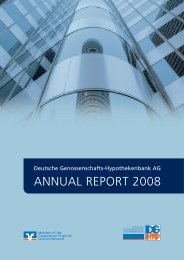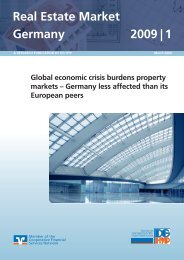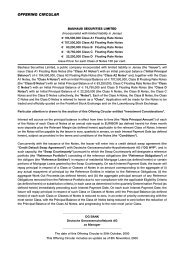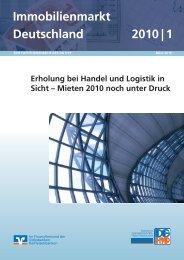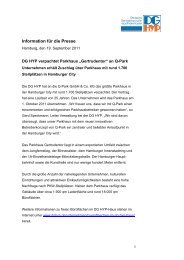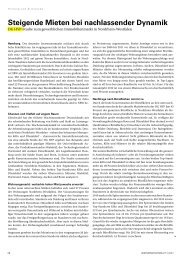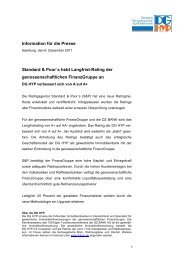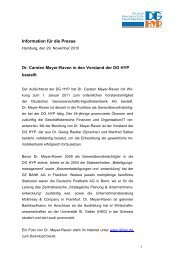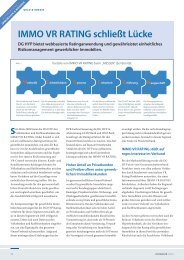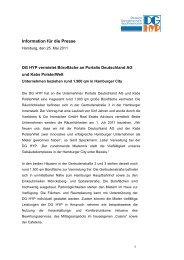Covered Bonds - DG Hyp
Covered Bonds - DG Hyp
Covered Bonds - DG Hyp
Create successful ePaper yourself
Turn your PDF publications into a flip-book with our unique Google optimized e-Paper software.
<strong>DG</strong> HYP COVERED BONDS – PFANDBRIEFE – QUALITY THE PATH OUT OF THE CRISIS SPECIAL MAY 2009<br />
�<br />
Proposition 2:<br />
The pfandbrief issuers‘ earnings will continue to be marked by the financial and economic<br />
crisis in 2009.<br />
Their reported 2008 numbers have made it evident that the visible scars from the financial<br />
crisis, though different issuers have been affected differently, generally go deep. The<br />
issuers’ mostly negative trading and investment results, due to valuation losses and losses<br />
on divestments of both straight assets and derivatives, have either resulted in annual net<br />
losses or have decimated what positive earnings there were. In other words the pfandbrief<br />
issuers have shared the same „fate“ as most other banks that do not hold pfandbrief<br />
licenses. We expect the earnings of banks that specialise in pfandbrief operations to remain<br />
pressurised in 2009 as they are forced to make big write downs and take heavy impairment<br />
charges as the negative feedback from the financial crisis continues to hit the real economy<br />
and specifically the commercial property markets.<br />
�<br />
Proposition 3:<br />
Their business models will generally change gradually, but not fundamentally.<br />
It is certainly still too early to provide a definite answer to the question of the extent to which<br />
the financial crisis has already changed the pfandbrief banks‘ business models and<br />
strategies, or is going to change them in future. What is clear at this point is that the crisis<br />
has forced the typical pfandbrief issuer to scale back new mortgage and state-sector<br />
lending.<br />
Taking the new-business data reported by the member banks of the vdp (Verband<br />
deutscher Pfandbriefbanken) as our yardstick, their overall new loan commitments during<br />
2008 were around 37% lower year-on-year in the mortgage credit business line and around<br />
41% down in the state-finance segment. Commercial property lending suffered the biggest<br />
drop, around 43%. The changes look much less dramatic at the lending book level (total<br />
credit extended). While the stock of outstanding mortgage loans has even increased by<br />
2.7%, there has been a decline of around 10% in state-sector loans. This is explained by<br />
the difference in the average maturities of the assets concerned.<br />
We take the view that these changes are not so much the product of a proactive choice to<br />
pursue a particular course of action, but more a passive adaption to the dramatic<br />
deterioration of the issuers‘ funding options and risk tolerance capacity. Among the<br />
causative factors we would cite are firstly the worsening of the available funding conditions,<br />
but more importantly investors‘ reduced absorption capacity and appetite, plus all the<br />
uncertainty over the future fate of the funding markets. On the other hand, internal factors<br />
are also in play that have to do with risk tolerance and capitalisation. The range of business<br />
options open to banks, their scope of discretion, has narrowed drastically during 2008,<br />
especially after the failure of Lehman. Since it went under, if not before, the funding side has<br />
been dictating the options available to the lending side – it now takes priority ahead of the<br />
lending side’s business potential, whereas the dominance in the relationship was probably<br />
the other way round in the past. These factors have largely prevented the German<br />
pfandbrief issuers from taking advantage of the present substantially wider margins on both<br />
mortgage and state-sector lending to the extent they would have wished.<br />
Will the pfandbrief issuers now abandon the state finance business after the catastrophe<br />
experienced by DEPFA, whose reliance on short-term funding went way too far? We believe<br />
that many pfandbrief issuers will choose to remain in this business. Lending to the<br />
Difficult mortgage markets as a<br />
burden for 2009<br />
Searching for the sustainable<br />
business model<br />
Declining new loan commitments<br />
Higher refinancing costs and<br />
changes in the risk tolerance are in<br />
play<br />
Pfandbrief issuers will remain in the<br />
public sector business<br />
15





